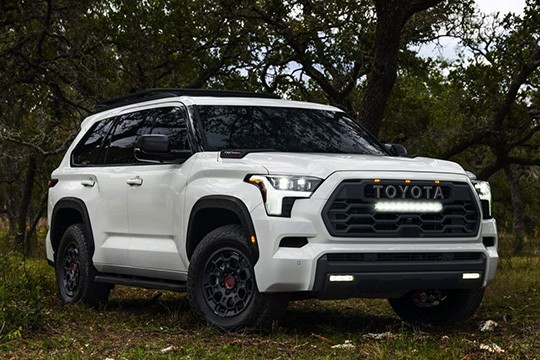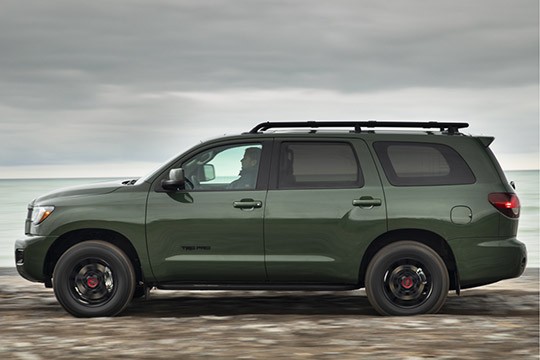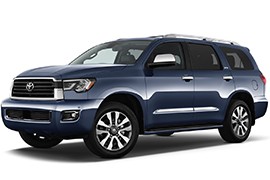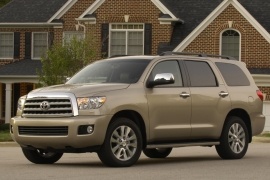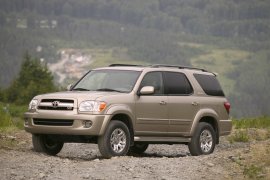TOYOTA Sequoia Models/Series Timeline, Specifications & Photos
First production year: 2000
Engines: , Gasoline
Body style: SUV (Sports Utility Vehicle)
Toyota unveiled the third generation of its largest SUV, the Sequoia, at the beginning of 2022 and built it on the same platform as the rugged Tundra pickup truck.
Introduced more than two decades ago, in 2000, the Sequoia heralded Toyota's entry in the same league with the Ford Excursion and Chevrolet Tahoe. In 2007, the Japanese carmaker introduced the second generation of its flagship SUV, apart from the Lexus brand. But it took another 14 years to launch a completely new model.
At the front, the car shared the main panels with its pickup-truck sibling, featuring similar headlights and a massive grille. Under the fat bumper, an aluminum-like shield protected the vehicle's underbelly. From the side, the biggest Toyota SUV from its 2022 lineup boasted a straight line that emerged from the hood to the D-pillar in the back. Its enlarged wheel fenders and quarter panels evoked a stronger presence. The carmaker suggested that it might resemble a sumo warrior.
Inside, the Sequoia offers room for up to eight passengers on three seat rows in a 2-3-3 configuration, depending on the options. For the interior, Toyota installed a dashboard similar to the Tundra's, albeit it added the trim level in front of the passenger and ambient lighting, depending on the version. In addition, a 14" touch-screen dominated the upper side of the center stack and provided Apple CarPlay and Android Auto connectivity.
Since it was based on the same platform as the Tundra, it featured a fully independent front suspension and a five-link in the back. The drivetrain offered a hybrid system that sends the power to the rear wheels or in all corners, depending on the trim level.
Toyota understood its clients’ desire for off-roading and introduced the TRD Pro version of the Sequoia at the 2019 Chicago Auto Show for the 2020 model year.
The second generation of the Sequoia appeared on the market in 2007, and by 2019, it was already an old model. Still, the full-size SUV enjoyed great success and helped the automaker survive during the world financial crisis of 2008-2010. After several other model year changes, in 2019 came the final update for the vehicle. Only this time, it wasn’t just about a new paint or a new set of light alloy wheels. Changes were mostly noticeable under the car’s skin and greatly improved the vehicle’s overall off-roading capabilities. After all, it shared its platform with the Tundra pickup, which was known for its sturdy chassis and great off-roading performance.
Toyota employed its TRD department to enhance the look of the Sequoia, and the result was a mean-looking off-road monster. At the front, the car sported a grille that was different from the rest of the range, with a black upper grille and the Toyota chromed lettering on it. It was flanked by new LED headlights and, on the bumper, the automaker added Rigid LED fog lamps. TRD also installed a metallic skid plate under the front of the car that protected the engine, the oil pan, and the gearbox.
From its profile, the Sequoia boasted its black TRD Pro badges mounted on the front doors. Customers could choose between four colors: Army Green (exclusive for the Sequoia TRD Pro), Super White, Midnight Black Metallic, and Magnetic Gray Metallic. To protect the vehicle’s sides, the automaker also offered a set of cast aluminum running boards and a roof rack. Another important upgrade, with benefits on the look and the functional factor, was the 18” BBS forged alloy wheels that equipped the vehicle as standard. Finally, at the back, the car featured a single exhaust with a black chromed tip adorned by the TRD logo.
Inside, the Sequoia offered a luxurious cabin with leather-wrapped seats. It offered room for seven, in a 2-2-3 configuration, with enough room for adult-sized passengers on the rearmost row. The second row featured captain seats, while the front ones sported the TRD Pro logos on the headrests. Toyota refreshed the infotainment system, adding Apple CarPlay to the infotainment unit that sat atop the center stack. The driver fronted a mixed instrument cluster fitted with binocular-style dials for the speedometer and tachometer that flanked other gauges and a small LCD.
But the most significant changes happened below the vehicle. While the engine remained the same 5.7-liter V8 gasoline powerplant, the suspension was greatly improved. For the transmission, Toyota used a six-speed automatic and a two-speed transfer case. The Torsen limited-slip differential sent the power to all corners all the time and could be locked at the touch of a button. The Sequoia TRD Pro featured Fox shocks in all corners with internal by-passes and bottom-out-control technology. The specific shock absorbers were thicker in diameter than those installed on the regular Sequoia.
Toyota introduced the second generation of the Sequoia in 2007 at the Los Angeles Auto Show, but after ten years on the market, the car finally got a proper refresh.
During the world’s financial crisis of 2008-2010, the Japanese automaker limited its spending to secure its economic future. After that, it started to improve its vehicles’ lineup, and the Sequoia was not among the first to get updated since it was pretty new as a model. Still, after almost a decade, in February 2017, the largest Toyota SUV finally got a well-deserved refresh, which was more than just a new bumper and a new stereo inside. Furthermore, the Sequoia received essential off-road underpinnings that allowed the three-row vehicle to take families to the top of a mountain and back safely.
While the car’s exterior sizes remained the same, there were significant changes in the Sequoia’s look. At the front, the new LED headlights also incorporated the daytime running lights, creating a sharper look for the aged vehicle. Furthermore, Toyota added LED fog lamps in the bumper. Another noticeable difference was the grille’s design, which sported a chromed surrounding and different horizontal slats than on the previous model. Last but not least, the air intake housed in the bumper made room for the radar needed for Toyota’s latest safety systems that came with the 2018 Sequoia.
From its profile, the automaker didn’t make significant improvements to the vehicle, apart from versions fitted with the newly introduced TRD Sport grade. That allowed customers to travel on rough roads and perform some off-road tricks thanks to the increased ground clearance and beefier tires. That version came with a black grille, 20” alloy wheels, and black finish badges.
Customers could feel some of the most significant upgrades inside the vehicle, where Toyota installed a standard 6.1” touchscreen for the Entune infotainment unit and an eight-speaker sound system. The driver fronted a new instrument cluster featuring the Optitron gauges and a 4.2” TFT multi-information display between the speedometer and tachometer. Like its predecessors, the 2018 Sequoia was available with room for up to eight people on three rows of seats and a massive cargo area. The automaker drastically improved the vehicle’s safety with the addition of the TSS-P (Toyota Safety Sense P) system, which integrated the pre-collision, automatic braking, lane-changing, and sway warning systems; on top of that, the full-size SUV came with adaptive cruise control.
Under the hood, Toyota installed a powerful 5.7-liter V8 engine that sent its power to the rear or in all corners via a six-speed automatic transmission. A transfer case with low-range gear was offered for 4WD versions. Despite being a massive vehicle, the adaptive variable suspension with electronic damper control kept the car well planted to the road. In addition, the rear air suspension kept the SUV leveled while towing or carrying heavy loads.
Toyota introduced the second generation of its full-size SUV Sequoia at the 2007 Los Angeles Auto show, and it was more powerful and fuel-efficient.
Just before the world was struck by a global financial crisis, the Japanese automaker introduced the second generation of the Sequoia on the North American market. This time, Toyota made its research and development team find more answers from customers in order to create a better vehicle. They went so extensive that they even asked where the drivers prefer to have the filler cap.
From the design point of view, Toyota made the Sequoia look like a Sumo warrior, with a commanding front end dominated by a trapezoidal grille adorned by chromed trims. Unsurprisingly, the headlights were not as big as on other American SUVs. In the bumper, the carmaker added a secondary air intake to help cool the engine. The flared wheel arches showed a muscular look, emphasizing the vehicle's powerful stance.
Toyota offered the Sequoia with three rows of seats, and thanks to the large cabin, it could provide enough comfort for all eight passengers that could accommodate inside the vehicle. The front bucket seats were separated by a wide center console that hosted the armrest with a storage compartment and the shifter. A new infotainment system was placed on the center stack and controlled via its buttons or the additional commands from the steering wheel.
Another area where the Sequoia was vastly improved was on the mechanical side. Apart from the improved 5.6-liter V8 engine, it also got a new five-speed automatic as an option and stronger front and rear differentials. The latter was also available with a different ratio for improved towing capabilities.
Based on the same chassis as the Tundra, the Sequoia was the largest vehicle on the market that wore a Toyota badge at the front.
The Japanese carmaker waited a while before entering the competition against the Ford Expedition, GMC Yukon, and Chevrolet Tahoe but was fell short on punching the Excursion or the Suburban. Toyota introduced it just a few months later after the full-size Tundra.
From the front, it offered that commanding view over the road, with a truck-like grille enhanced by a chromed silver slat in the middle, matching the color of the V-8 badge. Its steep windshield resembled the one from the Tundra and was followed on top by a long roof with full-size roof rails. From its sides, depending on the options, the car featured fixed side steps. A set of body-colored plastic moldings adorned the front and rear wheel arches. Unlike its main competitors, the Tundra's designers made a raked-forward C-pillar behind the rear doors, followed by a glass panel and blackened D-pillars, creating a wrapped-around illusion glass back with a floating roof.
Inside, Toyota offered room for eight on three seat rows. Even though the dashboard and the steering wheel resembled the Tundra, the rest of the cabin was luxurious enough to make the owner forget about the car's pickup base. The carmaker installed a leather-clad interior, a ceiling-mounted screen for the rear passengers, and a sunroof on the top trim level.
Under the hood, Toyota installed the same 4.7-liter V-8 engine used by the Lexus LX470 and the Land Cruiser. It paired it to a four-speed automatic transmission until 2004, and then it replaced it with a five-speed automatic gearbox. For the all-wheel-drive version, Toyota installed a Torsen center differential, but the car was available as a rear-wheel-drive only as well.
